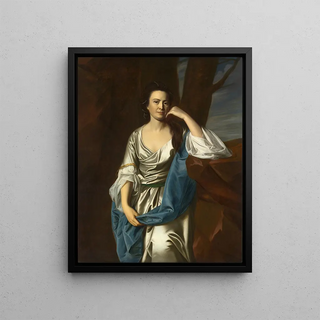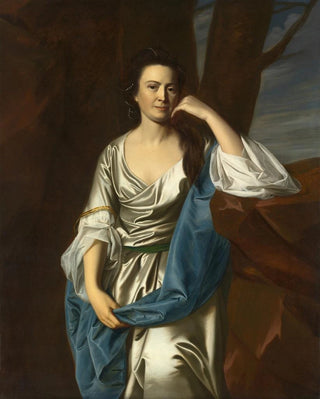Art print | Catherine Greene - John Singleton Copley


View from behind

Frame (optional)
Catherine Greene - John Singleton Copley – Engaging Introduction
In the rich and diverse landscape of art history, certain works stand out for their ability to capture not only a moment but also the very essence of an era. The depiction of Catherine Greene by John Singleton Copley is one of those creations that transcends mere portraiture to become a window into the past. This painting, emblematic of the 18th century, evokes the grace and dignity of a woman who, in addition to being the wife of an influential man, embodies the values and aspirations of a society in full transformation. Through this artwork, Copley invites us to explore the subtleties of female identity and the social dynamics of his time, while offering a fascinating glimpse into the artistic conventions of his era.
Style and uniqueness of the work
Copley's style is characterized by striking realism, a technique that allows him to render every detail with almost photographic precision. In the portrait of Catherine Greene, the drapery of her dress, the reflections of light on her skin, and the expression on her face all testify to exceptional talent. Copley does not merely depict his subject; he creates an atmosphere, an ambiance that envelops the viewer. The composition is carefully thought out, with each element having its place and significance. The colors, both rich and delicate, contribute to a visual harmony that draws the eye and invites contemplation. This portrait is not limited to a simple representation; it evokes a story, a personality, a world.
The artist and his influence
John Singleton Copley is often regarded as one of the greatest portraitists of his time. Born in Boston, he managed to establish himself in an artistic environment dominated by European influences while remaining faithful to his American heritage. Copley captured the spirit of his era, blending baroque style and neoclassicism, thus creating works that still resonate today. His innovative approach to portraiture, which combines meticulousness and psychology, paved the way for many subsequent artists. By depicting historical figures and influential characters, Copley not only documented his time but also shaped American artistic identity. His impact on art is undeniable, and

Matte finish

View from behind

Frame (optional)
Catherine Greene - John Singleton Copley – Engaging Introduction
In the rich and diverse landscape of art history, certain works stand out for their ability to capture not only a moment but also the very essence of an era. The depiction of Catherine Greene by John Singleton Copley is one of those creations that transcends mere portraiture to become a window into the past. This painting, emblematic of the 18th century, evokes the grace and dignity of a woman who, in addition to being the wife of an influential man, embodies the values and aspirations of a society in full transformation. Through this artwork, Copley invites us to explore the subtleties of female identity and the social dynamics of his time, while offering a fascinating glimpse into the artistic conventions of his era.
Style and uniqueness of the work
Copley's style is characterized by striking realism, a technique that allows him to render every detail with almost photographic precision. In the portrait of Catherine Greene, the drapery of her dress, the reflections of light on her skin, and the expression on her face all testify to exceptional talent. Copley does not merely depict his subject; he creates an atmosphere, an ambiance that envelops the viewer. The composition is carefully thought out, with each element having its place and significance. The colors, both rich and delicate, contribute to a visual harmony that draws the eye and invites contemplation. This portrait is not limited to a simple representation; it evokes a story, a personality, a world.
The artist and his influence
John Singleton Copley is often regarded as one of the greatest portraitists of his time. Born in Boston, he managed to establish himself in an artistic environment dominated by European influences while remaining faithful to his American heritage. Copley captured the spirit of his era, blending baroque style and neoclassicism, thus creating works that still resonate today. His innovative approach to portraiture, which combines meticulousness and psychology, paved the way for many subsequent artists. By depicting historical figures and influential characters, Copley not only documented his time but also shaped American artistic identity. His impact on art is undeniable, and






